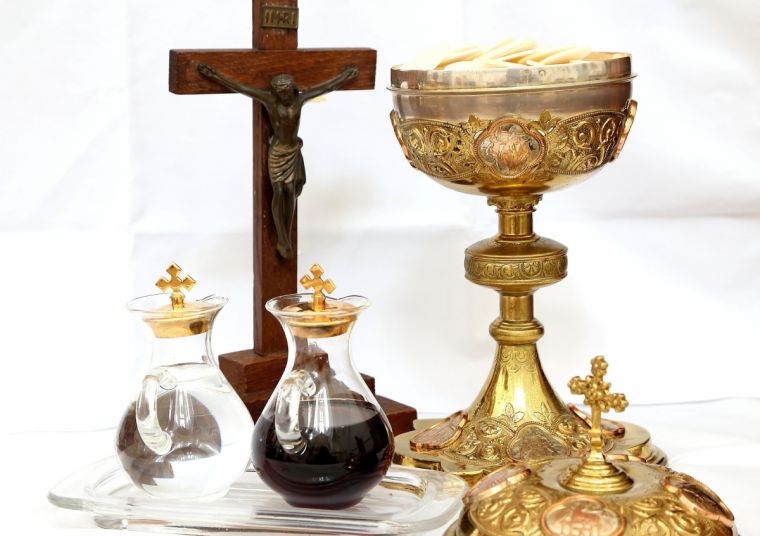Wafer 'bleeds' in Polish church: Genuine miracle or hoax?

The Roman Catholic Bishop of Legnica in Poland has made an extraordinary claim about a "eucharistic miracle".
During a Christmas Day mass in 2013 a consecrated wafer or Host fell on the floor at the Church of St Jack. It was, according to Catholic practice, picked up and put in a water-filled container or 'vasculum' to dissolve. However, red stains were noticed in the water and the former bishop, Stefan Cichy, set up a commission to investigate.
Reports say that a fragment of the wafer was sent to the Department of Forensic Medicine in Szczecin, which according to the current bishop, Zbigniew Kiernikowski, concluded: "In the histopathological image, the fragments of tissue have been found containing the fragmented parts of the cross striated muscle." The tissue is "most similar to the heart muscle with alterations that often appear during the agony. The genetic researches indicate the human origin of the tissue."
In other words, a bit of wafer turns out to be human heart muscle that's been subjected to stress and pain.
So what on earth is going on here?
The story relates, of course, to the Catholic belief in transubstantiation – that the bread and wine of communion become in a literal sense the body and blood of the Lord Jesus Christ at the moment of consecration. While the 'accidents' – the outward form of bread and wine – remain unchanged, the substance or inner reality of the elements has changed. So the 'miracle' involves the manifestation of this inner reality to human senses.
And, of course, 'eucharistic miracles' have been known before; the blood of St Januarius in Naples is said to liquify a few times a year, while it's claimed that an 8th-century miracle in which the Host changed to flesh and blood has been validated by modern science.
Protestants hold a range of views on what happens at communion, from the pure memorialism associated with the Reformer Zwingli to 'high' doctrines of the Real Presence. But they all reject the doctrine of transubstantiation, which in the times of persecution was often the test which decided whether someone would live or be burned at the stake. So most Protestants – and many Catholics – are going to approach a claim like this with a good deal of scepticism.
In principle, of course, God is God and if He wants to perform a miracle like this he can. But it is, on the face of it, exceedingly unlikely that in this case He has.
It's no reflection on the bishop to suggest that other explanations – ranging from fraud to a genuine mistake by someone or other – are more likely. And without impugning the Church's motives, the bishop is also reported as saying he will instruct the parish church to "prepare a suitable place for a display of the Relic so that the faithful could give it the proper adoration". He is obviously preparing for a stream of pilgrims bringing doubtless much-needed income.
And it has to be said that the Church has form here. Such manifestations of the divine have always drawn the faithful to worship (and if Protestants are tempted to dismiss such things as superstition, they might like to consider the drawing power of 'signs and wonders' churches and charismatic megachurch pastors). But one of the things that drove the English Reformation of the 16th century was the exposure of many relics of the saints as money-making frauds. When Henry VIII's commissioners went round examining the monasteries they found extraordinary practices. At Hailes Abbey in Gloucestershire, the monks claimed they had some of Christ's blood in a bottle, but that only people whose sins had been forgiven could see it. Thousands of pilgrims flocked there and knelt in front of it – some successfully, some not, depending on the size of their donations.
The commissioners found the bottle was clear on one side and opaque on the other. A monk told them: "You see, my lords, when a rich penitent appears, we turn the vessel on the thick side; that, you know, opens his heart and his purse."
At Boxley in Kent there was a crucifix which winked and nodded if an offering was accepted. If it was too small, it turned away in disgust. The commissioners found the wires pulled by the priests behind the scenes. The image was taken to the king, who said: "I do not know whether I ought not to weep rather than laugh, on seeing how the poor people of England have been fooled for so many centuries." The 'Black Book' in which the evidence against the monasteries was recorded was destroyed in the realm of the Catholic Queen Mary, for obvious reasons.
So what about the 'miracle' of Legnica?
If the reports are correct, it's perplexing; but we might conclude that an explanation requires the talents of a sleuth rather than of a theologian. On the other hand: if the church does become a site of pilgrimage, we should hope and pray that the faithful have a genuine encounter with the risen Christ – and are not too disappointed if the story falls apart.
Follow Mark Woods on Twitter: @RevMarkWoods











